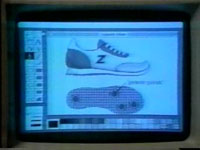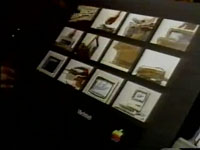

"Making the Macintosh" is an online project documenting the history of the Macintosh computer. The Macintosh stands at a cusp in the history of computing and Silicon Valley: it brought together (and sometimes transformed) a number of technical and conceptual threads in computing that developed in the 1960s and 1970s, but it also was responsible for sparking new movements in computing. This project collects and publishes primary material on the Macintosh's development and early reception. It draws on the extensive holdings of the Stanford University Library's Department of Special Collections, the personal papers of engineers and technical writers involved in the Macintosh project, and interviews conducted for the project.
The exhibit features primary documents, such as memos tracing the evolution of the Macintosh mouse; images, such as technical drawings, stills from commercials, notes from user tests; and interviews with members of the Macintosh development team, technical writers, and founders of user groups.
Since launching in July, the site has received hundreds of e-mails from readers, with everything from suggestions for new features and subjects, to bug reports, to typos. These have all been extremely useful, especially in those cases when I've needed feedback on something new. So keep those cards and letters coming!
The exhibit has won several awards and been the subject of various articles, most recently a featured review in the Harvard Business School's Working Knowledge Web site, and a "Bookmarks" column in the Chronicle of Higher Education.
"Making the Macintosh" is organized around several primary subjects. In each, readers will first find an introductory essay that explains the significance of the subject; provides some background necessary to make sense of the archival collection; and suggestions regarding how to get started in the documents. There is also a complete list of documents, interviews, and images for each section. The site takes this approach because the character of the collection makes it possible for the documents-- and the people who created them-- to speak for themselves, without the usual intermediary scholarly apparatus of interpretation and explication.

Counterculture and Computing. Some have argued that the invention of the personal computer in the 1970s was driven by both technological innovations (most notably the introduction of the microprocessor) and a desire to make computing power accessible to the general public.
The Early Macintosh. This section focuses on the Macintosh project when it was under the direction of Jef Raskin.
The Apple Mouse. The Apple mouse has become a standard in the computer input industry. However, little attention has been given to how the mouse was moved "from the laboratory to the living room," as one of its designers put it. This section provides documents and drawings tracing that evolution.
Technical Documentation. The role technical writers played on the Macintosh project has gone largely unexamined. This section discusses the work of technical writing, its uses at Apple before the Macintosh project, and the role writers played in shaping the operating system software.

Marketing the Macintosh. The 1984 commercial is the best-known part of the Macintosh launch, but other techniques developed or refined for the launch have been even more influential in high-tech marketing and public relations.
User Groups. User groups were a significant early market for Macintosh; they also served as software distributors, sources of technical information, and incubators for hardware and software companies.
Those interested in historiographic questions and read more on why these subjects were chosen.

This project is ongoing. There is already a backlog of interviews and primary materials that could not be included in this release, and will be added shortly in an update; we are also working to explore and document other aspects of the Macintosh's history.